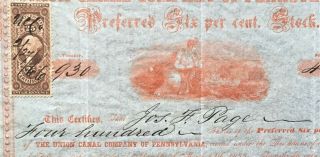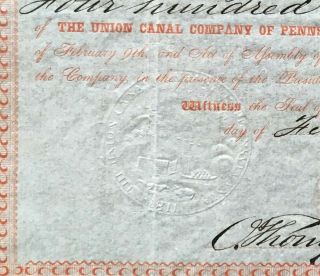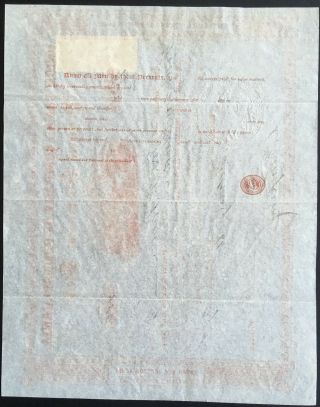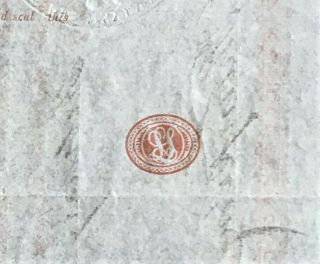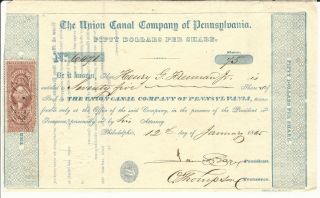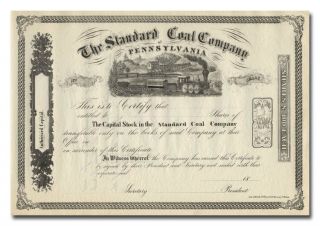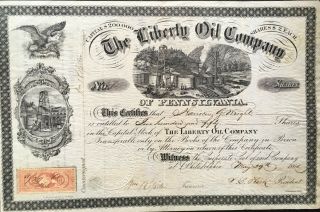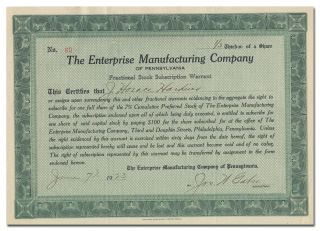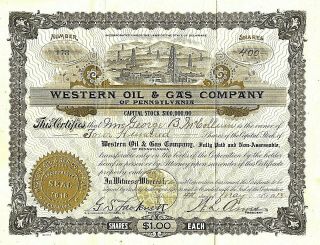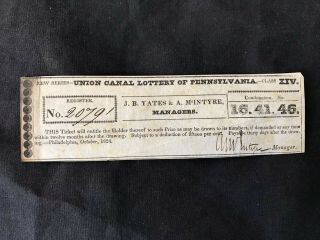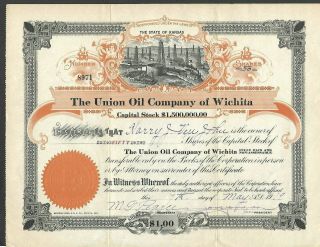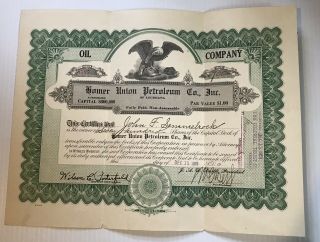UNION CANAL COMPANY Of PENNSYLVANIA Stock 1866 HISTORIC COMPANY, RARE CERT, VF,
Item History & Price
| Reference Number: Avaluer:4317366 |
UnionCanal Company of Pennsylvania.Stock issued on February 27, 1866 in Philadelphia. Incorporated in1811 in the State of Pennsylvania. Embossed company seal lower left.25-cent revenue stamp dated 1866 affixed. Certificate No.930 was issued to Joseph F. Page for 400shares of “preferred 6%” at $50 per share ($20, 000 –equivalent of about $350, 000 in today’s dollars). Printed afterthe company name: “…. created under the Resolutions of theStockholders of February 9th, and Act... of Assembly of March13th, 1855.” Original ink signatures of companypresident (illegible) and treasurer O. Thompson. Certificate is about7.5” x 9.5”.Reddish-orangeprint on a high-quality vellum paper – watermark seen on reverseside. Vignettewith an early engraving of an allegorical woman seated on rocksoverlooking a town in the valley below with industry, steamboat andrailroad.Veryattractive historic certificate in Excellent Condition.
Condition: Very Fine+, three very light vertical folds, no creases, no tears, very light signs of any wear/handling/discoloration, Uncancelled.Printer: Clarks, Pres., 68 Dock Street (likely Dock Street in Philadelphia).
Company History:
In1811, the Schuylkill and Susquehanna Canal Company andthe Delaware and Schuylkill Canal Company were reorganized andmerged as the Union Canal Company of Pennsylvania. The twocompanies that merged were chartered by the Pennsylvania GeneralAssembly in 1791. At the time of the initial construction in theearly 1790s, Philadelphia was involved in an intense rivalry withBaltimore for the supremacy as a shipping port. The canal wasbacked by Philadelphia businessmen as a means to divert commercialtraffic from following the Susquehanna River downriver to theChesapeake Bay, its more natural destination. From west to east, the route of the canal was to follow Swatara Creek upstream fromMiddletown to Quittapahilla Creek, which it then followed upstreampast Lebanon and Myerstown to its headwaters. It then crossedoverland to Clarks Run at the headwaters of Tulpehocken Creek, following Tulpehocken Creek downstream to Reading on theSchuylkill River. It was to follow the Schuylkill downriver tothe Delaware River at Philadelphia. Construction began in 1792under the direction of William Weston, an experienced British canalengineer. The first shovel of earth was turned by President GeorgeWashington. By 1793, several miles of the canal were dug and fivelocks were built between Myerstown and Lebanon before financialdifficulties caused the work to cease. In 1795 the PennsylvaniaLegislature authorized a lottery to raise funds for the canal'sconstruction. The largest canal lottery in U.S. history, it held 50drawings over the next two decades, awarding $33 million in prizemoney, with only $270, 000 reaching the canal companies. Constructionresumed in 1821 by the Union Canal Company of Pennsylvania;work began in 1821 and the Canal was completed for the opening in1828. The 102 locks of the Canal were originally built too small(8-1/2' x 75') and could notaccommodate the larger boats from the Pennsylvania Canal and theSchuylkill Canal. Enlargement took place beginning in 1855 bythe Union Canal Company ofPennsylvania, increasinglock size to 17' x 90'.
Additional historic information: Acanal linking the Susquehanna and Delaware valleys in southeasternPennsylvania was first proposed in 1690 by William Penn, the founder of the Pennsylvania Colony.Nearly a century passed before a route for the canal was surveyed byDavid Rittenhouse and William Smith between 1762 and 1770, the firstcanal ever surveyed in the U.S. Spurred by the 1791 discovery ofanthracite in the upper Susquehanna Valley. The Union Canal was a towpath canal that existed in southeastern Pennsylvania during the 19th century. First proposed in 1690 to connect Philadelphia with the Susquehanna River, it ran approximately 75 milesfrom Middletown on the Susquehanna below Harrisburg to Reading on the Schuylkill River.Although construction began in 1792 during the George Washington Administration, financial difficulties delayed its completion until1828. Called the "Golden Link, " it provided a criticalearly transportation route for the shipment of anthracite coal and lumber eastward to Philadelphia. Although closed in the 1880s, remnants ofthe canal remain, most notably the Union Canal Tunnel, a hand-builtengineering marvel that is the oldest existing transportation tunnelin the United States. One of the principal challenges was the construction of a 729-foottunnel through the ridge separating the headwaters of Quittapahilla Creek and Clarks Run. The drilling of the tunnel was by hand, using gunpowder toblast though argillaceousslatewith veins of hard flinty limestone80 feet below the summit of the ridge. The progress of the tunnel wasapproximately 15 feetper week, requiring over two years to complete. Another engineeringdifficulties was the continual resupply of water at the summit level, a task that was compounded by leakage and required an elaboratepumping mechanism. Although the initial design called for theconstruction of a canal from the Susquehanna to the Delaware, the1825 opening of the rival SchuylkillNavigationfrom Reading to Philadelphia prompted the Union Canal Company tofocus solely on the Middletown-Reading portion of the canal. Thecanal was completed in 1828 under the direction of CanvassWhite, the preeminent canal engineer of the day. Upon its completion it was8-1/2 feetwide and had 93 locks.In 1832 a 22-mile branch canal was constructed northward from thewaterworksalong the Swatara Creek to PineGrove.The branch canal served as feeder for the summit level as well asallowing the transport of anthracite from the mountains, which becamea principal revenue source for the canal operation. The charter ofthe canal company allowed it to build lateral railroad lines from thecanal to reach coal mines. It built a 3.5-mile line from the end ofthe branch canal to LorberryJunctionin 1830, which was operated by horse power. This connected it to theLorberryCreek Railroad andbrought coal traffic to the canal. In 1844, the track was leased tothe SwataraRailroad, which extensively refurbished the right-of-wayand began to operate it by steamlocomotive inabout 1850. By the 1840s the narrow size of the canal locks preventedthe passage of the larger bargesthat were adopted for use on the PennsylvaniaMain Lineand Schuylkill Navigation. The existing width restricted barges to 25tons.From 1841 to 1858, under the direction of chief engineer LoammiBaldwin, Jr., the canal was widened to 17 feet)to allow the passage of the larger boats carrying 75 to80tons. In the process of the rebuilding, the tunnel through the summitridge was shortened to 600 feet.The widening of the canal allowed for a brief period of prosperity inthe late 1850s and early 1860s. In June 1862 a flood on Swatara Creekdamaged the western portion of the canal, completely destroying thePine Grove feeder upon which the canal company depended for revenue.The flood prompted costly repairs that were compounded with continualwater supply problems. The connecting railroad was leased to thePhiladelphiaand Reading Railroadon July 26, 1862, and sold outright in January 1866. The completionof the LebanonValley Railroad in1857 from Reading to Harrisburg cut into the canal revenues, forcingits closure in 1881.
PAYMENTAND SHIPPING Please read certificate description details shown above before bidding. Please contact me with any questions before bidding. Payment by PayPal only. Shipping within the U.S. is by USPS First Class Mail ($4.00 for packages weighing 13 ounces or less) – shipping for packages weighing over 13 ounces will be shown on your invoice. If another shipping method is requested, a revised invoice will be sent. International buyers need to wait for my invoice before paying. Combined shipping cost will be offered for multiple items won – please wait for invoice before paying, or if specific shipping method or insurance is requested. Multiple items will be shipped together in one package. All packages will be shipped with certificates placed in plastic sleeves with cardboard backing and marked “Do Not Bend”. I do not profit on shipping costs charged. Items typically shipped within two days of payment.RETURNSAND GUARANTEE: Buyer satisfaction and authenticity of certificate is guaranteed – returns are accepted with 14 days of purchase (buyer pays return shipping cost unless item received is not as described in this listing). All certificates are originals – no reproductions.
Condition: Very Fine+, three very light vertical folds, no creases, no tears, very light signs of any wear/handling/discoloration, Uncancelled.Printer: Clarks, Pres., 68 Dock Street (likely Dock Street in Philadelphia).
Company History:
In1811, the Schuylkill and Susquehanna Canal Company andthe Delaware and Schuylkill Canal Company were reorganized andmerged as the Union Canal Company of Pennsylvania. The twocompanies that merged were chartered by the Pennsylvania GeneralAssembly in 1791. At the time of the initial construction in theearly 1790s, Philadelphia was involved in an intense rivalry withBaltimore for the supremacy as a shipping port. The canal wasbacked by Philadelphia businessmen as a means to divert commercialtraffic from following the Susquehanna River downriver to theChesapeake Bay, its more natural destination. From west to east, the route of the canal was to follow Swatara Creek upstream fromMiddletown to Quittapahilla Creek, which it then followed upstreampast Lebanon and Myerstown to its headwaters. It then crossedoverland to Clarks Run at the headwaters of Tulpehocken Creek, following Tulpehocken Creek downstream to Reading on theSchuylkill River. It was to follow the Schuylkill downriver tothe Delaware River at Philadelphia. Construction began in 1792under the direction of William Weston, an experienced British canalengineer. The first shovel of earth was turned by President GeorgeWashington. By 1793, several miles of the canal were dug and fivelocks were built between Myerstown and Lebanon before financialdifficulties caused the work to cease. In 1795 the PennsylvaniaLegislature authorized a lottery to raise funds for the canal'sconstruction. The largest canal lottery in U.S. history, it held 50drawings over the next two decades, awarding $33 million in prizemoney, with only $270, 000 reaching the canal companies. Constructionresumed in 1821 by the Union Canal Company of Pennsylvania;work began in 1821 and the Canal was completed for the opening in1828. The 102 locks of the Canal were originally built too small(8-1/2' x 75') and could notaccommodate the larger boats from the Pennsylvania Canal and theSchuylkill Canal. Enlargement took place beginning in 1855 bythe Union Canal Company ofPennsylvania, increasinglock size to 17' x 90'.
Additional historic information: Acanal linking the Susquehanna and Delaware valleys in southeasternPennsylvania was first proposed in 1690 by William Penn, the founder of the Pennsylvania Colony.Nearly a century passed before a route for the canal was surveyed byDavid Rittenhouse and William Smith between 1762 and 1770, the firstcanal ever surveyed in the U.S. Spurred by the 1791 discovery ofanthracite in the upper Susquehanna Valley. The Union Canal was a towpath canal that existed in southeastern Pennsylvania during the 19th century. First proposed in 1690 to connect Philadelphia with the Susquehanna River, it ran approximately 75 milesfrom Middletown on the Susquehanna below Harrisburg to Reading on the Schuylkill River.Although construction began in 1792 during the George Washington Administration, financial difficulties delayed its completion until1828. Called the "Golden Link, " it provided a criticalearly transportation route for the shipment of anthracite coal and lumber eastward to Philadelphia. Although closed in the 1880s, remnants ofthe canal remain, most notably the Union Canal Tunnel, a hand-builtengineering marvel that is the oldest existing transportation tunnelin the United States. One of the principal challenges was the construction of a 729-foottunnel through the ridge separating the headwaters of Quittapahilla Creek and Clarks Run. The drilling of the tunnel was by hand, using gunpowder toblast though argillaceousslatewith veins of hard flinty limestone80 feet below the summit of the ridge. The progress of the tunnel wasapproximately 15 feetper week, requiring over two years to complete. Another engineeringdifficulties was the continual resupply of water at the summit level, a task that was compounded by leakage and required an elaboratepumping mechanism. Although the initial design called for theconstruction of a canal from the Susquehanna to the Delaware, the1825 opening of the rival SchuylkillNavigationfrom Reading to Philadelphia prompted the Union Canal Company tofocus solely on the Middletown-Reading portion of the canal. Thecanal was completed in 1828 under the direction of CanvassWhite, the preeminent canal engineer of the day. Upon its completion it was8-1/2 feetwide and had 93 locks.In 1832 a 22-mile branch canal was constructed northward from thewaterworksalong the Swatara Creek to PineGrove.The branch canal served as feeder for the summit level as well asallowing the transport of anthracite from the mountains, which becamea principal revenue source for the canal operation. The charter ofthe canal company allowed it to build lateral railroad lines from thecanal to reach coal mines. It built a 3.5-mile line from the end ofthe branch canal to LorberryJunctionin 1830, which was operated by horse power. This connected it to theLorberryCreek Railroad andbrought coal traffic to the canal. In 1844, the track was leased tothe SwataraRailroad, which extensively refurbished the right-of-wayand began to operate it by steamlocomotive inabout 1850. By the 1840s the narrow size of the canal locks preventedthe passage of the larger bargesthat were adopted for use on the PennsylvaniaMain Lineand Schuylkill Navigation. The existing width restricted barges to 25tons.From 1841 to 1858, under the direction of chief engineer LoammiBaldwin, Jr., the canal was widened to 17 feet)to allow the passage of the larger boats carrying 75 to80tons. In the process of the rebuilding, the tunnel through the summitridge was shortened to 600 feet.The widening of the canal allowed for a brief period of prosperity inthe late 1850s and early 1860s. In June 1862 a flood on Swatara Creekdamaged the western portion of the canal, completely destroying thePine Grove feeder upon which the canal company depended for revenue.The flood prompted costly repairs that were compounded with continualwater supply problems. The connecting railroad was leased to thePhiladelphiaand Reading Railroadon July 26, 1862, and sold outright in January 1866. The completionof the LebanonValley Railroad in1857 from Reading to Harrisburg cut into the canal revenues, forcingits closure in 1881.
PAYMENTAND SHIPPING Please read certificate description details shown above before bidding. Please contact me with any questions before bidding. Payment by PayPal only. Shipping within the U.S. is by USPS First Class Mail ($4.00 for packages weighing 13 ounces or less) – shipping for packages weighing over 13 ounces will be shown on your invoice. If another shipping method is requested, a revised invoice will be sent. International buyers need to wait for my invoice before paying. Combined shipping cost will be offered for multiple items won – please wait for invoice before paying, or if specific shipping method or insurance is requested. Multiple items will be shipped together in one package. All packages will be shipped with certificates placed in plastic sleeves with cardboard backing and marked “Do Not Bend”. I do not profit on shipping costs charged. Items typically shipped within two days of payment.RETURNSAND GUARANTEE: Buyer satisfaction and authenticity of certificate is guaranteed – returns are accepted with 14 days of purchase (buyer pays return shipping cost unless item received is not as described in this listing). All certificates are originals – no reproductions.




